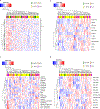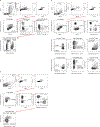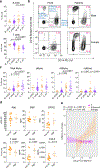Sex differences in immune responses that underlie COVID-19 disease outcomes
- PMID: 32846427
- PMCID: PMC7725931
- DOI: 10.1038/s41586-020-2700-3
Sex differences in immune responses that underlie COVID-19 disease outcomes
Abstract
There is increasing evidence that coronavirus disease 2019 (COVID-19) produces more severe symptoms and higher mortality among men than among women1-5. However, whether immune responses against severe acute respiratory syndrome coronavirus (SARS-CoV-2) differ between sexes, and whether such differences correlate with the sex difference in the disease course of COVID-19, is currently unknown. Here we examined sex differences in viral loads, SARS-CoV-2-specific antibody titres, plasma cytokines and blood-cell phenotyping in patients with moderate COVID-19 who had not received immunomodulatory medications. Male patients had higher plasma levels of innate immune cytokines such as IL-8 and IL-18 along with more robust induction of non-classical monocytes. By contrast, female patients had more robust T cell activation than male patients during SARS-CoV-2 infection. Notably, we found that a poor T cell response negatively correlated with patients' age and was associated with worse disease outcome in male patients, but not in female patients. By contrast, higher levels of innate immune cytokines were associated with worse disease progression in female patients, but not in male patients. These findings provide a possible explanation for the observed sex biases in COVID-19, and provide an important basis for the development of a sex-based approach to the treatment and care of male and female patients with COVID-19.
Conflict of interest statement
Figures







Update of
-
Sex differences in immune responses to SARS-CoV-2 that underlie disease outcomes.medRxiv [Preprint]. 2020 Jun 26:2020.06.06.20123414. doi: 10.1101/2020.06.06.20123414. medRxiv. 2020. Update in: Nature. 2020 Dec;588(7837):315-320. doi: 10.1038/s41586-020-2700-3. PMID: 32577695 Free PMC article. Updated. Preprint.
Comment in
-
Sex-biased Immune Responses Following SARS-CoV-2 Infection.Trends Microbiol. 2020 Dec;28(12):952-954. doi: 10.1016/j.tim.2020.10.002. Epub 2020 Oct 10. Trends Microbiol. 2020. PMID: 33077340 Free PMC article.
-
A finding of sex similarities rather than differences in COVID-19 outcomes.Nature. 2021 Sep;597(7877):E7-E9. doi: 10.1038/s41586-021-03644-7. Epub 2021 Sep 22. Nature. 2021. PMID: 34552251 No abstract available.
Similar articles
-
Sex differences in immune responses to SARS-CoV-2 that underlie disease outcomes.medRxiv [Preprint]. 2020 Jun 26:2020.06.06.20123414. doi: 10.1101/2020.06.06.20123414. medRxiv. 2020. Update in: Nature. 2020 Dec;588(7837):315-320. doi: 10.1038/s41586-020-2700-3. PMID: 32577695 Free PMC article. Updated. Preprint.
-
Viral loads, lymphocyte subsets and cytokines in asymptomatic, mildly and critical symptomatic patients with SARS-CoV-2 infection: a retrospective study.Virol J. 2021 Jun 12;18(1):126. doi: 10.1186/s12985-021-01597-x. Virol J. 2021. PMID: 34118952 Free PMC article.
-
Diagnosis of SARS-CoV-2 infection in the setting of the cytokine release syndrome.Expert Rev Mol Diagn. 2020 Nov;20(11):1087-1097. doi: 10.1080/14737159.2020.1830760. Epub 2020 Oct 12. Expert Rev Mol Diagn. 2020. PMID: 32990479
-
T Cells: Warriors of SARS-CoV-2 Infection.Trends Immunol. 2021 Jan;42(1):18-30. doi: 10.1016/j.it.2020.11.002. Epub 2020 Nov 13. Trends Immunol. 2021. PMID: 33277181 Free PMC article. Review.
-
Immune profiling of COVID-19: preliminary findings and implications for the pandemic.J Immunother Cancer. 2021 May;9(5):e002550. doi: 10.1136/jitc-2021-002550. J Immunother Cancer. 2021. PMID: 33963016 Free PMC article. Review.
Cited by
-
Persistent disabilities 28 months after COVID-19 hospitalisation, a prospective cohort study.ERJ Open Res. 2024 Oct 28;10(5):00104-2024. doi: 10.1183/23120541.00104-2024. eCollection 2024 Sep. ERJ Open Res. 2024. PMID: 39469273 Free PMC article.
-
The Trajectory of Antibody Responses One Year Following SARS-CoV-2 Infection among Indigenous Individuals in the Southwest United States.Viruses. 2024 Oct 5;16(10):1573. doi: 10.3390/v16101573. Viruses. 2024. PMID: 39459907 Free PMC article.
-
Sex-Based Differences in Pulmonary Function and Cardiopulmonary Response 30 Months Post-COVID-19: A Brazilian Multicentric Study.Int J Environ Res Public Health. 2024 Sep 27;21(10):1293. doi: 10.3390/ijerph21101293. Int J Environ Res Public Health. 2024. PMID: 39457266 Free PMC article.
-
Aromatase, testosterone, TMPRSS2: determinants of COVID-19 severity.Biol Sex Differ. 2024 Oct 24;15(1):84. doi: 10.1186/s13293-024-00658-4. Biol Sex Differ. 2024. PMID: 39449074 Free PMC article.
-
The short-term and long-term prognosis of discharged COVID-19 patients in Guangdong during the first wave of pandemic.Sci Rep. 2024 Oct 14;14(1):23994. doi: 10.1038/s41598-024-76013-9. Sci Rep. 2024. PMID: 39402204 Free PMC article.
References
Publication types
MeSH terms
Substances
Grants and funding
LinkOut - more resources
Full Text Sources
Other Literature Sources
Medical
Miscellaneous

